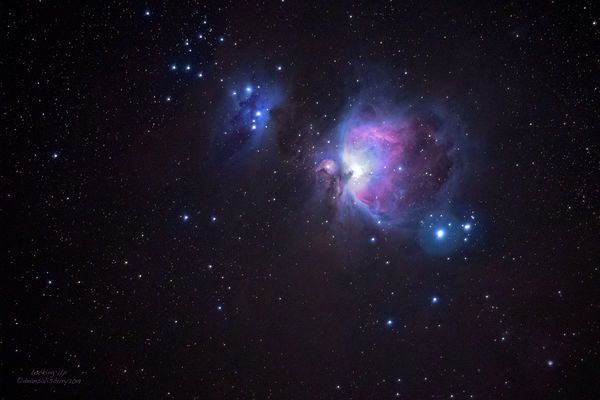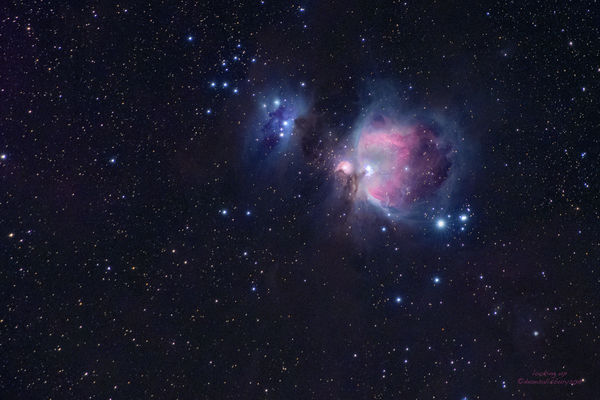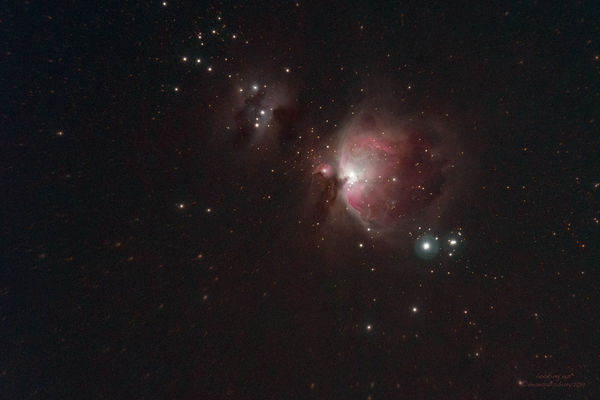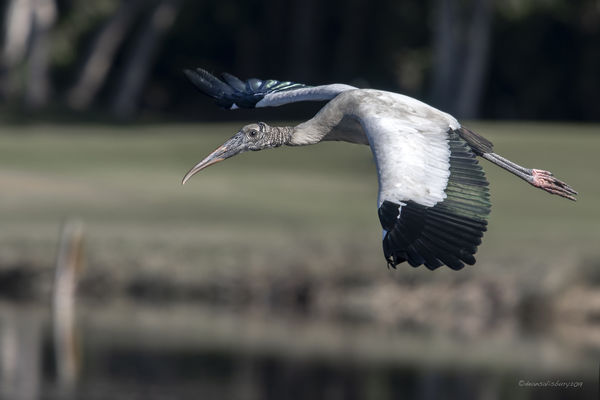Nikkor 300mm f4e PF for Astrophotography?
Jan 14, 2019 14:36:21 #
I started pointing my camera up at the night sky about two years ago. Tripod mounted Nikon D700 with a fast super wide making 30 second exposures of the Milky Way. Got hooked. Bought a tracker this past summer. Ioptron SkyGuider Pro. Got pleasing results with an old Nikkor 135mm f2.8Q on the D700 but wanted more reach. Mounted the 300mm PF and Nikon D500 (my birding outfit) on the SkyGuider and made the image below. I liked the result. I showed my wife. She wondered why the bright star Orion Iota (at the 5 o'clock position) had a soft fuzzy haze surrounding it. I shrugged my shoulders...I had no idea. I searched and could not find any astro images made with the 300 PF.
The next night was clear so I replaced the 300PF with my old 70-200 f2.8 and made the second image below. I used the same exposure setting for both (90 seconds, f4, ISO 2500) and stacked 8 images using PS. Orion Iota looks much different to me.
Does my Nikkor 300mm f4e PF have a cataract?
The next night was clear so I replaced the 300PF with my old 70-200 f2.8 and made the second image below. I used the same exposure setting for both (90 seconds, f4, ISO 2500) and stacked 8 images using PS. Orion Iota looks much different to me.
Does my Nikkor 300mm f4e PF have a cataract?
Jan 14, 2019 15:31:19 #
Its a reflection commonly showing up in astrophotos around bright stars. I assume the 2 lenses you are using are constructed differently. (Sorry, I'm a novice on camera lenses)
I do notice your tracking is off a bit. Do you have good polar alignment? Overall, nice images.
I do notice your tracking is off a bit. Do you have good polar alignment? Overall, nice images.
Jan 14, 2019 17:56:37 #
Quote:
Yep, tracking is off. I discovered tripod about 1/4 bubble out of level after second imaging session.I do notice your tracking is off a bit. Do you have good polar alignment? Overall, nice images.
Jan 14, 2019 18:16:01 #
There are others here that will chime in on the lens used, they are far more qualified to discuss than I am.
But as I mentioned, good job overall.
But as I mentioned, good job overall.
Jan 15, 2019 08:00:13 #
I found this on the net http://www.salzgeber.at/astrophotography/full-spectrum-modification-of-a-nikon-d7000-part-ii
in the image of the california nebula you can see the same sort of bloated star within your image.
the author of the link suspects his inline hoya filter maybe to blame (causing reflection)
there are a few tests you can perform as follows
lower your ISO
lower your fstop a few clicks
lower your exposure duration
try an alternative area of the sky to see how the stars turn out (Cygnus)
these suggestions may help you ascertain the sweet spot / right combination of settings for said lens
in the image of the california nebula you can see the same sort of bloated star within your image.
the author of the link suspects his inline hoya filter maybe to blame (causing reflection)
there are a few tests you can perform as follows
lower your ISO
lower your fstop a few clicks
lower your exposure duration
try an alternative area of the sky to see how the stars turn out (Cygnus)
these suggestions may help you ascertain the sweet spot / right combination of settings for said lens
Jan 15, 2019 08:17:22 #
Marc G wrote:
i found this on the net http://www.salzgeber.at/as... (show quote)
Thank you Marc...I appreciate your research and suggestions and will implement them. I really like the 300mm PF for my nature photography and its light weight (1 pound 11 oz) makes it a good passenger on the tracker.
Jan 18, 2019 09:48:41 #
[quote=7awol]Thank you Marc...I appreciate your research and suggestions and will implement them.
Marc...implemented most of your suggestions with the attached result. Competing with an 85% Moon but I think that there is enough data to draw some conclusions. I reduced ISO to 2200 (from 2500), reduced aperture to f6.7 (from f4) and reduced exposure by 1/3 (from 90 seconds to 60). 16 subs stacked in PS. Orion Iota still showing blooming. Some further research on nature photographers reviews of this lens shows instances of lens flare when the sun is included in the image. I absolutely love this lens for my bird photography. So...most likely an aberration of the phased fresnel design. I appreciate your interest.
Marc...implemented most of your suggestions with the attached result. Competing with an 85% Moon but I think that there is enough data to draw some conclusions. I reduced ISO to 2200 (from 2500), reduced aperture to f6.7 (from f4) and reduced exposure by 1/3 (from 90 seconds to 60). 16 subs stacked in PS. Orion Iota still showing blooming. Some further research on nature photographers reviews of this lens shows instances of lens flare when the sun is included in the image. I absolutely love this lens for my bird photography. So...most likely an aberration of the phased fresnel design. I appreciate your interest.
Jan 20, 2019 22:16:48 #
Marc G wrote:
i found this on the net http://www.salzgeber.at/as... (show quote)
Here is a Ken Rockwell comparison of different Nikon 300mm lenses over the years.
https://kenrockwell.com/nikon/comparisons/300mm-f4.htm
Jan 22, 2019 07:27:37 #
[quote=7awol]
The Stork photograph is super sharp, so no doubts about the lenses ability.
Can i ask what the single, un-stacked / processed frames looks like, is Iota bloated straight off the camera?
I ask as this bloating maybe caused during post processing.
If so, you may have use a star mask or mask the larger stars before histo stretching / processing
7awol wrote:
Thank you Marc...I appreciate your research and su... (show quote)
The Stork photograph is super sharp, so no doubts about the lenses ability.
Can i ask what the single, un-stacked / processed frames looks like, is Iota bloated straight off the camera?
I ask as this bloating maybe caused during post processing.
If so, you may have use a star mask or mask the larger stars before histo stretching / processing
Jan 22, 2019 07:33:32 #
Marc G wrote:
The Stork photograph is super sharp, so no doubts about the lenses ability.
Can i ask what the single, un-stacked / processed frames looks like, is Iota bloated straight off the camera?
I ask as this bloating maybe caused during post processing.
If so, you may have use a star mask or mask the larger stars before histo stretching / processing
Can i ask what the single, un-stacked / processed frames looks like, is Iota bloated straight off the camera?
I ask as this bloating maybe caused during post processing.
If so, you may have use a star mask or mask the larger stars before histo stretching / processing
I have also just found this
https://petapixel.com/2015/01/10/closer-look-nikons-new-phase-fresnel-pf-lens-technology/
that illustrates potential lenses flare with the fresnel lens.
The link also recommends a software fix for fresnel lenses
Jan 22, 2019 08:27:23 #
[quote=Marc G]The Stork photograph is super sharp, so no doubts about the lenses ability.
Can i ask what the single, un-stacked / processed frames looks like, is Iota bloated straight off the camera?
Thank you for responding. Yes, Iota is bloated in the single un-stacked and un-processed frames. The Nikon Nx filter solution looks like a step in the right direction. The info that you provided is helpful.
Can i ask what the single, un-stacked / processed frames looks like, is Iota bloated straight off the camera?
Thank you for responding. Yes, Iota is bloated in the single un-stacked and un-processed frames. The Nikon Nx filter solution looks like a step in the right direction. The info that you provided is helpful.
Mar 13, 2019 21:18:35 #
7awol wrote:
I started pointing my camera up at the night sky a... (show quote)
7awol et al...great photos! However, I am looking for recommendations for unguided/untracked tips if you have a moment to offer your advice?... My hope is to be able to get photos close to the quality of the two Orion Nebulas above (understanding I am looking at taking darn near a thousand photos or more to increase the SNR).
Specifically, I shoot with a Nikon D500 (all NR and internal settings off) and would like to shoot with my Nikon AF-S 55-300mm f/4.5-5.6G ED VR at about 150mm, framing Orions belt and the Nebula. SS about 1-1.3secs depending on star trails. My question is with the ISO, though. I have been reading a lot of the forums mentioning around 12,800 ISO and others, on the lower ISO team, stating shoot lower (400-1600) ISO. I am under the impression that the lower ISO will be for the tracked photos with longer exposures, but am open to any thoughts on the matter.
Additionally, I have a Tokina 11-16 mm and the Nikkor Kit lens that came with the camera (Nikon 16-80 mm F/2.8-4.0 DX) which also takes some killer MW photos if you believe either of those would be better for my intro-to-AP stacking lesson.
I know the equipment listed isn't ideal, but my goal is to get "brilliant at the basics" before purchasing mounts, scopes, etc...
Lastly, I recognize personal trial and error will be key, but was hoping to get some good lessons learned from someone shooting with similar equipment and getting the type of results I am seeking.
Thanks for any help and happy shooting.
SW-
Mar 13, 2019 21:42:17 #
Mar 13, 2019 23:07:34 #
Europa wrote:
Where will you be shooting from? What’s your sky like?
I'll be shooting in VA generally. Staunton River State Park (VA) which is a Dark Sky Site and rates appx a Bortle scale value of 3-4. I will also be headed to Shenandoah National State Park as well to see how clear of skies I can get there. Maybe 2.5 or so on the west side of the park if I am extremely lucky. The rest will be near Charlottesville, VA., which gets around a 4 or so.
Correction to the Bortle ratings...I had them backwards (sorry)...all sites will be around 5-7.
Mar 13, 2019 23:18:04 #
Thanks, that info will be helpful. We have several knowledgeable folks on this forum, you may want to create a new post. It’ll help grab their attention.
If you want to reply, then register here. Registration is free and your account is created instantly, so you can post right away.







